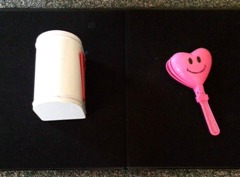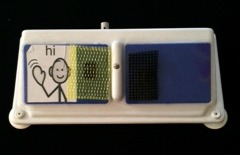Circle times in early childhood classrooms (preschool and early elementary) frequently follow the same format. Students have an opportunity to say hello, participate in attendance, review the calendar, sing a couple of songs, and read a story. There are fun and easy ways to incorporate literacy and choice-making opportunities during circle.
Saying “Hello”

Some students may need support when engaging in greetings. Students may use dual voice output devices. This dual switch has a button that represents “hello” and one that represents “bye”. Textures can be added to represent hello and goodbye. Although this is abstract, a beginning “reader” will learn what each texture represents. Use contrasting colors for the textures and add the braille word under the texture. Large print can also be used for print learners. By using a dual voice output switch, students work on literacy skills: understanding that textures represent words, touching braille, or looking at print. Students also have an opportunity to make a choice: to respond by saying “hi”, “bye” or saying nothing at all. Students who choose to say “bye” can be redirected, if necessary, e.g. “You said ‘goodbye’ and we are saying ‘Hi’.” Sometimes students say “goodbye” and smile or laugh afterwards, displaying a sense of humor. Students may also use an iPad App to say “Hi” / “Bye”. Answers HD has an app that can be easily customized using large squares, bright contrasting colors, and a recorded voice.
When I use augmentative communication devices in my classroom, I have a verbal student record the voice. This is a matter of personal preference: I appreciate the students hearing a child’s voice say hi/bye when they push a button rather that of an adult.
Attendance
 Attendance can be taken in many ways. Students can say their name when called, say “here”, raise their hand, smile etc. In my preschool class, my students have a personal button (switch) with their name pre-recorded. They have their “name texture” paired with braille and print on their switch. This name texture has been chosen by the students at the beginning of the year. It is used as an identifier for any of their belongings. I also send the texture with them to kindergarten. I sing a song and then ask who came to school that day. Each student has an opportunity to push their button to say their name.
Attendance can be taken in many ways. Students can say their name when called, say “here”, raise their hand, smile etc. In my preschool class, my students have a personal button (switch) with their name pre-recorded. They have their “name texture” paired with braille and print on their switch. This name texture has been chosen by the students at the beginning of the year. It is used as an identifier for any of their belongings. I also send the texture with them to kindergarten. I sing a song and then ask who came to school that day. Each student has an opportunity to push their button to say their name.
In an Itinerant class of students K-5, we take attendance somewhat differently. Each student has a name card with their texture, print and braille. I present two cards on a small black board. One is their name and the other is a different student. The students choose their name, and put it on the attendance board. The top of the attendance board reads “These friends came to school today”. After they have chosen their name, they choose something to hold while we sing hello, such as a glitter baton, pom-pom, etc.
Calendar
 The daily calendar can be very abstract for some students. Students who are braille or large print readers should have a personal calendar to reference during circle time. Students who have typical vision can reference the calendar squares visually. By giving students with a visual impairment a personal calendar they can tactually review the days and the week. As the teacher counts up to the current day, students can follow along visually or tactually on each row.
The daily calendar can be very abstract for some students. Students who are braille or large print readers should have a personal calendar to reference during circle time. Students who have typical vision can reference the calendar squares visually. By giving students with a visual impairment a personal calendar they can tactually review the days and the week. As the teacher counts up to the current day, students can follow along visually or tactually on each row.
Songs are a fun part of circle time. Teachers can show two objects, each one of which represents a song choice. I believe that it is helpful to sing each of the songs to start, showing the object with the song. This week we are singing about mailboxes and hearts (for Valentine’s Day). I present the choices against a small blackboard for the students that can see them. For students that need to touch the objects, they are given ample time to explore them. The students are then given a choice for which song they would like to sing. Each student should have an opportunity to take a turn. Movement songs also provide opportunities for choice-making. The teacher can sing the song and then the student choses which movement to do in the song. Examples of the movement songs can be found at the bottom of this post.
Story Time
 Another activity during circle time is to read a story. When reading a story, make sure to have a textured book with large print and braille, and coordinating storybox items. This supports early literacy through concept development, and pairing words with print or braille. If I’m not reading a book, I will read a “flannel board story” This week we are doing “5 Little Hearts”. I put 5 hearts (small heart boxes) on a small blackboard. Students who are using augmentative communication devices push a switch with the recorded line from the story. Then we take the heart off the board together, again working left to right. The story continues with each student taking a turn to vocalize, repeat the line verbally or with the switch, and taking off a heart.
Another activity during circle time is to read a story. When reading a story, make sure to have a textured book with large print and braille, and coordinating storybox items. This supports early literacy through concept development, and pairing words with print or braille. If I’m not reading a book, I will read a “flannel board story” This week we are doing “5 Little Hearts”. I put 5 hearts (small heart boxes) on a small blackboard. Students who are using augmentative communication devices push a switch with the recorded line from the story. Then we take the heart off the board together, again working left to right. The story continues with each student taking a turn to vocalize, repeat the line verbally or with the switch, and taking off a heart.
The key to choice-making and literacy is using real objects and materials during the morning circle routine. Students should have opportunities to use real objects to support their choices. As students are introduced to real objects and begin to recognize them, they build their vocabulary. A large vocabulary supports literacy development and choice-making.
Song Example





